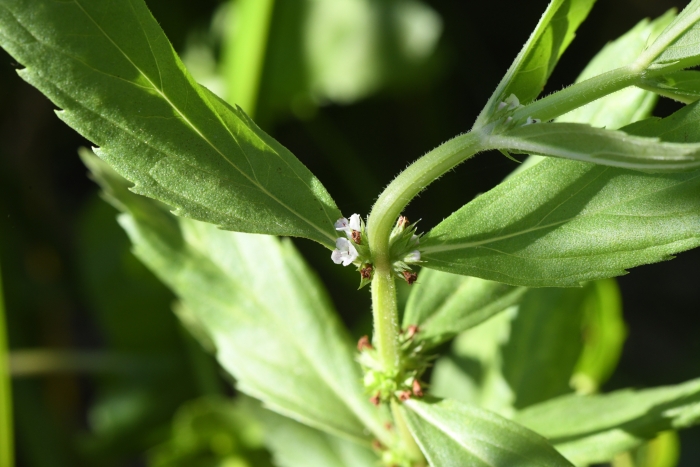Rough Bugleweed
(Lycopus asper)
Rough Bugleweed (Lycopus asper)
/
/

Chloe and Trevor Van Loon
CC BY 4.0
Image By:
Chloe and Trevor Van Loon
Recorded By:
Copyright:
CC BY 4.0
Copyright Notice:
Photo by: Chloe and Trevor Van Loon | License Type: CC BY 4.0 | License URL: http://creativecommons.org/licenses/by/4.0/ | Rights Holder: Chloe and Trevor Van Loon | Publisher: iNaturalist | Date Created: 2023-08-28T16:48:32-07:00 |

























Estimated Native Range
Summary
Lycopus asper, commonly known as Rough Bugleweed, is a perennial herb that is native to wetlands, stream banks, and other moist, low-lying areas across much of North America. It typically grows to a height of up to 3 feet (1 meter) and features square stems with pairs of oppositely arranged, coarsely toothed leaves. The small, white flowers are borne in the leaf axils during the summer months and are not particularly showy, but they do attract pollinators such as bees. Rough Bugleweed spreads by rhizomes, which have thick, knobby tips, allowing it to form dense colonies.
Rough Bugleweed is valued for its ability to thrive in wet conditions and is often used for erosion control along waterways. It is also a component of naturalistic plantings in moist garden areas. In terms of cultivation, it prefers full sun to part shade and consistently moist to wet soils. While it is not typically grown for its ornamental qualities, its medicinal properties have been recognized in traditional herbal medicine, where it is used to treat various ailments. Gardeners should be aware that it can spread aggressively in ideal conditions, potentially becoming invasive.CC BY-SA 4.0
Rough Bugleweed is valued for its ability to thrive in wet conditions and is often used for erosion control along waterways. It is also a component of naturalistic plantings in moist garden areas. In terms of cultivation, it prefers full sun to part shade and consistently moist to wet soils. While it is not typically grown for its ornamental qualities, its medicinal properties have been recognized in traditional herbal medicine, where it is used to treat various ailments. Gardeners should be aware that it can spread aggressively in ideal conditions, potentially becoming invasive.CC BY-SA 4.0
Plant Description
- Plant Type: Herb
- Height: 0.5-1.5 feet
- Width: 1-2 feet
- Growth Rate: Moderate
- Flower Color: White
- Flowering Season: Summer, Fall
- Leaf Retention: Deciduous
Growth Requirements
- Sun: Part Shade, Full Shade
- Water: High
- Drainage: Fast, Medium, Slow
Common Uses
Low Maintenance, Water Garden
Natural Habitat
Native to wetlands, stream banks, and moist, low-lying areas across much of North America
Other Names
Common Names: Rough Bugleweed, Rough Water Horehound, Western Water-Horehound, Western Bugleweed
Scientific Names: , Lycopus asper, Lycopus maritimus, Lycopus obtusifolius, Phytosalpinx aspera,
GBIF Accepted Name: